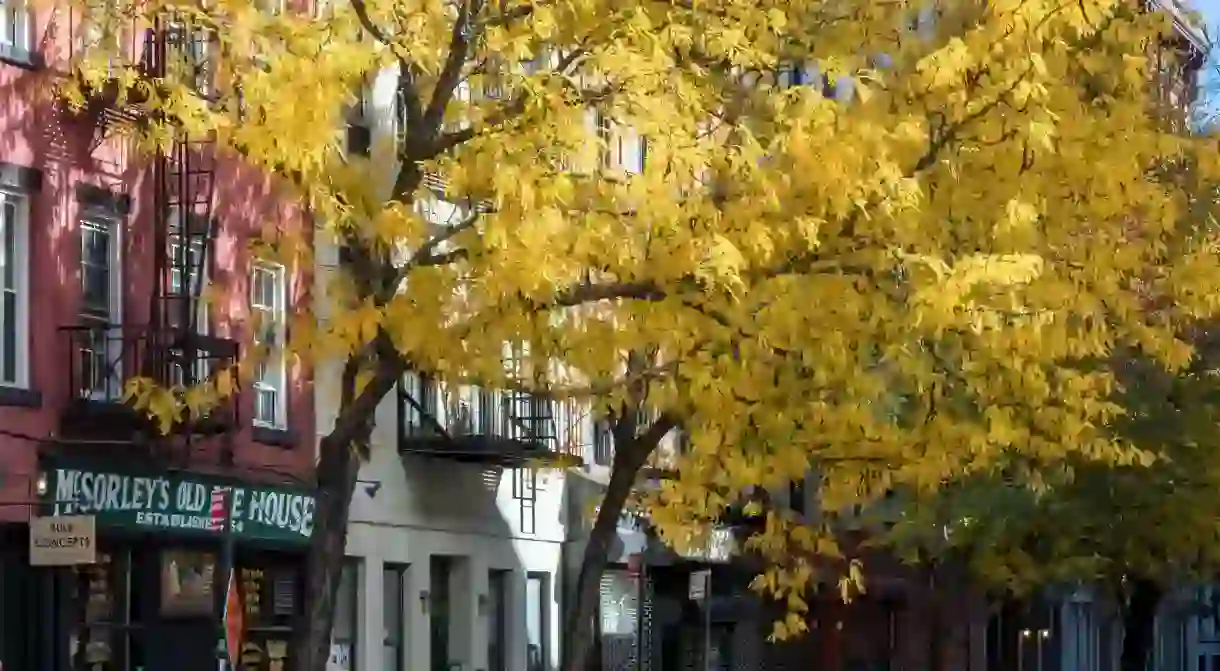7 Places in the East Village That Impacted the History of Poetry

Manhattan’s East Village neighborhood has served as a refuge for artists and poets since its secession from the Lower East Side. Stomp around the same ground that was once trodden by Allen Ginsberg, EE Cummings, Frank O’Hara and Patti Smith.
New York is in a constant state of flux. Today’s residents become displaced tomorrow, and the East Village was forged on this inevitable premise. Originally a community of Orthodox Jews and Puerto Ricans, the area was previously just an extension of the Lower East Side, until it became a micro-neighborhood in the 1950s as it grew into a hub for artists. The Beats, the New York School of Poets and the Nuyorican Movement all congregated, lived and read in the East Village, giving the neighborhood its distinct character. Residents included WH Auden, Allen Ginsberg, Eileen Myles, Frank O’Hara and LeRoi Jones, among others. Read on to learn about seven places where the best minds of a generation live on.
John Varvatos (formerly CBGB)
Store

Today, it is home to designer jeans, but John Varvatos’s eponymous store on the Bowery is the former site of the famed venue CBGB, which originally housed punks in much more tattered stylings. Closed in 2006, CBGB was known as a home base for bands such as Blondie, Talking Heads, and the Ramones. Richard Hell, an early member of the band Television who departed to perform under his name, is credited with this sartorial trend. He often sported a ripped T-shirt with safety pins precariously holding the stitching together. Aside from his contribution to the world of clothing, however, he is known for – along with friends Patti Smith and Tom Verlaine – bridging the gap between poetry and punk. “Writing and reading is probably my main occupation, but I felt too isolated; I wanted more physical satisfaction. So, out of frustration with feeling doomed to irrelevance, we decided we were gonna make a band,” Hell told the Poetry Foundation. Varvatos has preserved the stage where Smith and Hell read verses, and tattered posters touting the CBGB bands adorn the wall.
St Mark’s Church in-the-Bowery
Church

Nuyorican Poets Café
Music Venue, Theater

Gem Spa
Deli, American

In an untitled 1969 poem about a night of unsuccessful cruising, Allen Ginsberg concluded, “Back from the Gem Spa, into the hallway, a glance behind / and sudden farewell to the bedbug-ridden mattresses piled soggy in dark rain.” The Village has changed dramatically since then. Following the gentrification of the ’90s, you can rest assured bedbugs can’t afford Bowery rent, but Gem Spa is still serving its signature egg creams, a drink that combines seltzer, syrup and milk. For more than 20 years, the newsstand was mere blocks from Ginsberg’s 437 E 12th Street apartment, and it became a de facto hangout spot for poets, punks and hippies alike. Ted Berrigan, of the second-generation New York School of Poets, also captured the unique location in verse. In his poem ‘Many Happy Returns,’ he wrote, “Everyone, it seems, is somewhere else / None are lost, tho. At least, we aren’t / GEM’S [sic] SPA: Corner of 2nd Avenue & St Mark’s Place) / I’m right here.”
Bowery Poetry Club
Theatre, Art Gallery, Library

In a 1995 New Yorker profile, Harvard professor and renowned literary critic Henry Louis Gates, Jr described Bowery Poetry Club founder Bob Holman as “the postmodern promoter who has done more to bring poetry to cafés and bars than anyone since [Lawrence] Ferlinghetti.” This praise is high but deserved. Holman has been an East Village staple since the late 1970s when he coordinated readings at the Poetry Project and introduced slam poetry to the Nuyorican Poets Café. When he opened Bowery Poetry Club in 2002, its goal was to continue this tradition, and with its open mics and curated readings on Sundays and Mondays, its commitment to the art would make past poets proud.
KGB Bar
Bar, Pub Grub, American
McSorley’s Old Ale House
Bar, Pub, Irish

“I was sitting in mcsorley’s,” Modernist free-verse poet EE Cummings begins a 1923 tribute to this famous bar. He continues, “outside it was New York and beautifully snowing / Inside snug and evil.” McSorley’s, opened in 1854, is the city’s oldest Irish pub. Abraham Lincoln, a poet in his own right, stopped by for a drink, and Jack Kerouac was 86’d more than once. The concept of The Village Voice was discussed here, and eventually, its offices were close enough that editors would stop by after work, including co-founder Norman Mailer.













